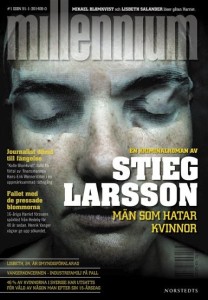DANGEROUS CHARACTERS
2/23/15 DANGEROUS CHARACTERS BY SONIA LINEBAUGH
In 1927 Elmer Gantry was banned in Boston and denounced from pulpits across the USA.
Gantry was a hard-drinking, womanizing, college football player, who grew into a sometimes sober, womanizing, evangelist minister. The denunciations weren’t because ministers were suddenly being held to a higher standard—it was because the fictional Elmer Gantry was a character in a novel by American author Sinclair Lewis.
In 2008, the Swedish novel, The Girl with the Dragon Tattoo, knocked American readers out of  their collective comfort zone. The story seemed to be about a journalist named Mikael, publisher of a Swedish political magazine, but several chapters in, readers’ imaginations got hijacked by “pierced and tattooed punk prodigy Lisbeth Salander.”
their collective comfort zone. The story seemed to be about a journalist named Mikael, publisher of a Swedish political magazine, but several chapters in, readers’ imaginations got hijacked by “pierced and tattooed punk prodigy Lisbeth Salander.”
Where do these characters come from?
Author Stieg Larsson said his tattooed character was penance for seeing Lisbeth, a girl he knew, gang-raped by three of his friends. Later he told Rolling Stone Magazine he heard the rape story second-hand. No matter, Larsson is the one who turned a rape victim into Lisbeth Slander whose “remoteness and her capacity for anger and violence are in contrast with a desperate vulnerability that she reveals only to the most unlikely of people.”
Sinclair Lewis found Elmer Gentry through research. January 13, 1926, his publisher Harcourt Brace, issued a press release announcing his departure for Kansas City to research his new novel. There, he attended as many as three services on a Sunday, and immersed himself in the life he would write about, sometimes preaching from pulpits as if he were himself a minister. For six weeks he held what the press called “Sinclair Lewis’s Sunday School” in his hotel room for 15-20 ministers at a time, all eager to argue their faith. The Christian Century reported on one meeting: “Soul-shaking moments come when Lewis speaks with the passion of an Old Testament prophet, demanding, “What sacrifices do you make? What risks will you take to end these paralyzing influences which you tell me are creeping over the church? Who will give up his wife and children, house and bank account? Who will literally follow Jesus into loneliness, ridicule and death? Why don’t you tell your congregations that you are agnostics?” As arguments took off, Lewis tuned his ear to the idiom of the ministry, filling notebooks with their phrases. “Where will you spend eternity? Saved by the blood of the Lamb. Get right with God.”
I read the words of the two books and the words that surround them, caught between an overweight self-aggrandizing hypocrite who sounds like certain contemporary politicians, who can preach a rousing, meaningless sermon, and an anti-social, genius computer hacker with an innate sense of morality. I’d lay money on Lisbeth.
Michael Ondaatje says, “The Girl with the Dragon Tattoo is an utterly fresh political and journalistic thriller that is also intimate and moral. In spite of its dark unearthings Stieg Larsson has written a feast of a book, with central characters you will not forget.”
Elmer Gantry is amoral, but equally memorable. Billy Sunday, one of those satirized in the novel, labelled Lewis “Satan’s cohort,” and said publicly that if he were God, he would have “soaked Mr. Lewis so hard that there would have been nothing left for the devil to levy on.” There were calls for the author to be imprisoned for five years, and threats of physical violence. Lewis survived until 1951 when his alcoholism caught up with him at age 65.
Author of The Girl with the Dragon Tattoo, Steig Larsson died of a heart attack at age 50 before his Millennium trilogy came into print in 2005. He’d trudged up seven flights of stairs to his office because the elevator was out. Though his partner said there was sign no foul play, his life had been threatened for years because of his work as an independent researcher of right-wing extremism.
What I’m coming to is this: If you birth a powerful, believable character, people will love her or him, and as many will love to hate him or her, and the author as well.
Notes: Rise of Sinclair Lewis, 1920-1930, by James M. Hutchisson [University Park: Penn State Press, 1996] quoting Edward Shillito’s “Elmer Gantry and the Church in America” [1927] on Lewis’s research in Kansas City. The original title of The Girl with the Dragon Tattoo, was Men Who Hate Women by the Swede Stieg Larsson. [Norstedts Förlag publisher 2005.] Muriel Dobbin of The Washington Times is quoted describing Lisbeth’s remoteness and capacity for anger. Michael Ondaatje blessed readers with four memorable characters in The English Patient: the nurse Hana, Caravaggio the thief, the Indian sapper Kip, and the unnamed English patient.
Sonia Linebaugh
Sonia L. Linebaugh is a freelance writer and artist. Her book At the Feet of Mother Meera: The Lessons of Silence goes straight to the heart of the Westerner’s dilemma: How can we live fully as both spiritual and material beings? Sonia has written three novels and numerous short stories. She’s a past president of Maryland Writers Association, and past editor of MWA’s Pen in Hand. Her recent artist’s book is “Where Did I Think I Was Going?,” a metaphorical journey in evocative images and text.